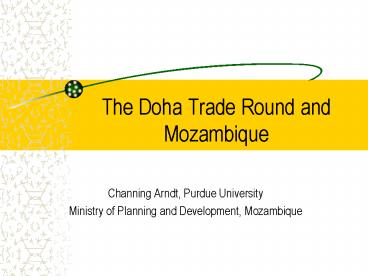The Doha Trade Round and Mozambique - PowerPoint PPT Presentation
Title:
The Doha Trade Round and Mozambique
Description:
A brutal civil war that endured for more than a decade. ... 'Engineering issues' associated with linking to the global model. ... Future Research. Price transmission. ... – PowerPoint PPT presentation
Number of Views:23
Avg rating:3.0/5.0
Title: The Doha Trade Round and Mozambique
1
The Doha Trade Round and Mozambique
- Channing Arndt, Purdue University
- Ministry of Planning and Development, Mozambique
2
Outline
- Background information
- Macroeconomic results from country CGE model
linked to GTAP model of global trade. - Poverty implications from a microsimulation model
using 8700 households. - Conclusions.
3
Purpose of Trade Liberalization
- Shift resources to sectors with comparative
advantage. - Foster links with the global economy which is
thought to yield dynamic advantages. - Technology transfer
- Skills acquisition
- Large demand source
4
(No Transcript)
5
Attributes
- Large volume of reasonably high quality arable
land - Long coastline
- Fisheries
- Tourism
- At least three decent natural harbors (transport
services to interior) - Mineral and other natural resources
- Not quite 19 million people
6
National Accounts 1996-2002
7
Poverty
- Despite growth and the positive attributes, more
than half the population is classified as
absolutely poor. - About 90 of the population lives on less than
twice the line defining absolute poverty. - Measured poverty rates are declining
- 54 in 2002-03
- 69 in 1996-97
- Overall, trend good level bad.
8
History
- Weak human capital development over the colonial
period even by African standards, - Failed socialist policies initiated shortly after
independence in 1975, and - A brutal civil war that endured for more than a
decade. - Poorest country in the world at the cessation
of hostilities in 1992.
9
Commonalities with other Countries
- A predominantly rural population with economic
and social indicators at less favorable levels in
rural areas (About 3 out of 4 poor people rural).
- An overwhelming dependence on agriculture in
rural areas. - Large distances and poor transport infrastructure
which result in substantial transport costs
particularly between distant regions. - Large price changes within seasons (post-harvest
low to pre-harvest high) for many basic
commodities. - High food shares in the total budget of the poor
(around 70 in the case of Mozambique).
10
Indicators of Food Price Dispersion
11
Maize Price Series
12
Home Consumption Expend. Share
13
Impact of Trade Margins
- PePwe(1-te)exr-icePice
- 50100 50 (initial equilibrium)
- 60110 50 (proportional magnification)
- PmPwm(1tm)exr-icmPicm
- 1005050 (initial equilibrium)
- 1055550 (proportional dampening)
14
Macro Structure (2001)
15
Mozambiques Three Economies
- Mega projects
- Aluminum smelting
- Hydro electric power generation
- Large scale mineral extraction (natural gas etc.)
- Subsistence and informal sectors
- Rest of the formal sector
16
Import Competition Indicator
1The figures in the above Table are drawn from
production and import information for 144 sectors
representing all commodities. The intent is to
discover which productive sectors compete
intensively with imports and which are
specialized meaning that either commodity supply
comes 90 from domestic production or 90 from
imports.
17
Static CGE Model
- Disaggregation
- 47 commodities
- 6 factors
- 2 households
- Accounts for marketing wedges for domestic
products, exports, and imports. - Accounts for home consumption
- Neoclassical closure
18
Simulations
NB Due to tariff binding overhand, Mozambican
tariff cuts in the Doha scenarios are essentially
zero.
19
Macroeconomic Results
20
Welfare Results
21
Microsimulation (Post Sim)
- Use data on 8700 households from household survey
to obtain information on expenditure shares and
shares in factor earnings. - Obtain price changes by commodity and wage
changes by factor from the CGE model. - Use this information to determine the first order
welfare impact of reform on each household in the
sample. - Note For home produced/consumed commodities, the
first order welfare impact of price changes is
zero.
22
Micro-simulation for DHSDT
23
Critique of Current Model
- Price transmission.
- Engineering issues associated with linking to
the global model. In particular, excessive export
price declines when Mozambique liberalizes. - Evasion, exemptions, and revenue replacement.
24
Robust Conclusions
- Static implications of Doha scenarios very small
due to - Lack of domestic tariff cuts
- Isolation of much of the economy
- Home consumption
- Insulation due to import margins
- Tendency of much of the economy to be
specialized - Even with full domestic liberalization, the
static implications for poverty are likely to be
small.
25
Implications
- Winters, McCulloch, and McKay (2004) More
liberal trading regimes are associated with
higher rates of economic growth. - Mozambique has an opportunity to move to a much
more open trade regime at relatively small
adjustment cost. - NB Full trade liberalization is not a sufficient
condition for growth.
26
Future Research
- Price transmission.
- Implication of large margins between FOB export
prices and farm/factory gate prices for
exportable commodities. - Revenue replacement with evasion and exemptions
considered explicitly.

